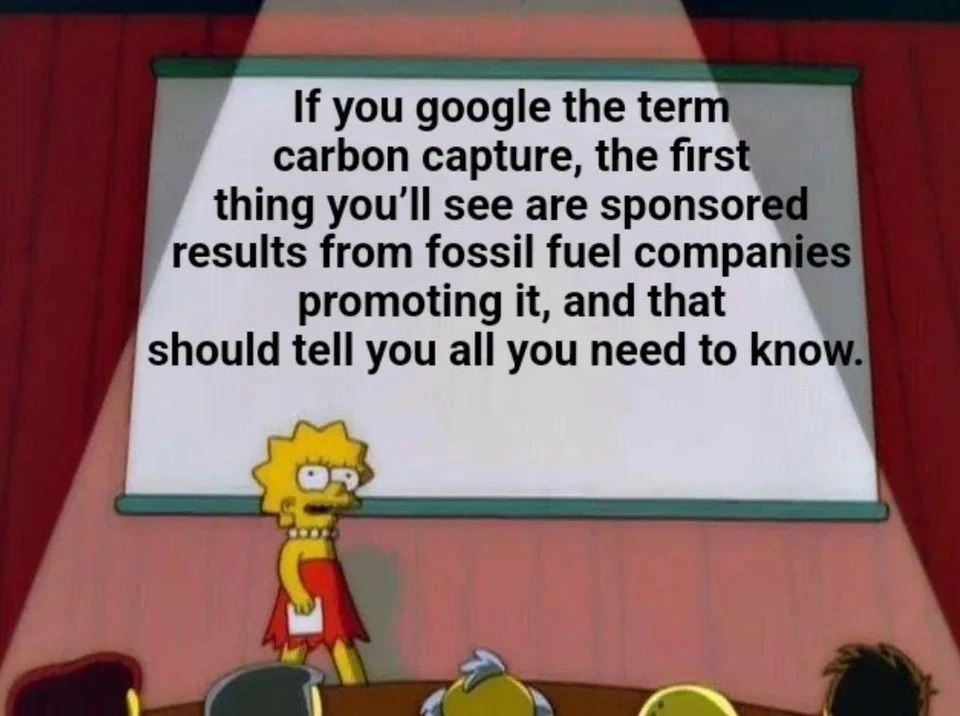this post was submitted on 10 Dec 2023
1408 points (96.4% liked)
solarpunk memes
2837 readers
28 users here now
For when you need a laugh!
The definition of a "meme" here is intentionally pretty loose. Images, screenshots, and the like are welcome!
But, keep it lighthearted and/or within our server's ideals.
Posts and comments that are hateful, trolling, inciting, and/or overly negative will be removed at the moderators' discretion.
Please follow all slrpnk.net rules and community guidelines
Have fun!
founded 2 years ago
MODERATORS
you are viewing a single comment's thread
view the rest of the comments
view the rest of the comments

Cheaper and scalable, yes, but what I'm getting at is the monoculture approach that most proponents take.
Also, it requires quite a bit of land mass to do, whereas with other options, you could potentially get similar benefits on smaller footprints.
I don't know enough about C offset dynamics to speak intelligently, but these are some of the things we need to consider.
I know enough of "C offset" to tell you that the problem is not C offset. You cannot and don't want to "offset" carbon. Carbon is literally the most important element for nature. Carbon is not a problem at all. Excess of CO2 is the problem. By excess I mean all CO2 that the system "earth" cannot transform in biological compounds. Transformation is primary done by plants, algae and bacteria. Unless we find a ecological, economically viable way to perform artificial transformation, the only solution is to increase number of natural "transformers" and decrease excess of CO2. Any other solution is thermodynamically useless, i.e. marketing. Carbon offset as a concept is pure marketing
Not trying to challenge you in this comment: I legit want to know more.
I'm I'm agreement on the need for transformation of C. I also agree that this is more than likely going to have to come from natural sources.
Why won't geological sequestration (e.g., chemically bonding it to rock, concrete, or Tailings) work? The thing I like about this method is that its super long term transformation (basically removal) as long as pH is controlled.
What methods look promising? I saw some biocell things that looked cool but way too niche to be practical.
Cutting emissions is definitely a key part of all this, but there's a lag phase before the warming if the emissions we emit now are realized. On top of this, there is woefully limited regulations around methane and n2o in key sectors.
We don't need transformation of C, we need transformation of just CO2 in other C based compounds.
The reason why capture doesn't really work, is because you need to spend a lot of energy to break CO bonds. Therefore any solution is based on very weak chemical bonds. It means that CO2 desorbes over time, substituted by other gases. And adsorption needs to break an equilibrium, against "natural direction of processes", i.e. requires energy.
Unless we find an efficient version of artificial photosynthesis, everything else is a waste of resources
I think I'm being too general in my wording, and you're getting hung up - an issue with typing on mobile is that I abbreviate everything. I mean CO2 sequestration/transformation.
Yet we see this in the biological sphere, where CO2 is taken into the plants, the plants die, get broken down, some of the CO2 they transformed into biomass is decomposed, and released as CO2 by the microbial community. Some of it (climate permitting) is transformed into soil organic carbon, which has multiple fractions. Some are short-lived, and readily broken down by the microbial community (more CO2 release); some fractions (humus, or protected SOC) are much longer lived, and result in a net loss from the C system.
All of this is unsurprising, given that this is the natural system, and therefore the system ultimately balances out, due to multiple sources of inputs and outputs.
I agree about cost/energy to break CO bonds, however, the examples I've seen seem to indicate that it's more stable long term.
Biochar seems interesting too, yet that requires a lot of energy input, and soil application has mixed results. You could make biochar, and then stuff it deeper into the soil or into geological formations, perhaps. Better if that biochar comes from food wastes, livestock production wastes etc. than plants.
As I said, it's a fucking huge problem with a million facets. We're so categorically fucked...